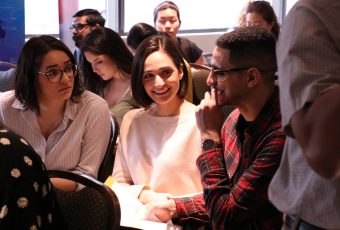Bond researcher takes third place in global genetic research competition
Bond University researcher and Teaching Fellow, Mark Barash, has taken third place in a global genetic research competition for his research which has the potential to help solve crimes and ancient mysteries.

Run by US-based bioinformatics company, Golden Helix, the inaugural awards attracted more than 50 entries from DNA researchers in more than 20 countries. Their submissions highlighted the extensive array of futuristic research being conducted in this field worldwide, with subjects ranging from humans to animals to fruits and vegetables.
Mr Barash was awarded third place for his investigations into the genetic factors that influence human appearance and facial features. His research has broad applications and could potentially help to solve crimes and ancient anthropological mysteries.
According to Mr Barash, his data is attracting a lot of attention as it open to a wide range of applications in medical, forensic and anthropological sectors.
“Based on my previous experience with the police force, the data can give forensic investigators an extraordinary advantage, enabling them to draw a ‘molecular portrait’ from a minute DNA sample left behind at a crime scene. In the absence of any eye witnesses or video evidence, for instance, they could estimate what the perpetrator looks like based on the DNA left at the crime scene,” Mr Barash said.
Mr Barash’s PhD supervisor, Associate Professor Lotti Tajouri, has a passion for ancient Egypt and sees the potential for this work to be used by anthropologists to show the world what ancient mummies would have looked like.
A former Forensic DNA Officer with the Israeli Police Force in Jerusalem, Mr Barash moved to Australia in 2010 to undertake his groundbreaking research at Bond University’s Faculty of Health Sciences and Medicine.
His PhD thesis focuses on identifying the “single nucleotide polymorphisms (SNPs) involved in the determination of facial morphology.”
“SNPs are single point variations in our DNA sequence, which are responsible in part for the facial differences and therefore in the way we look,” said Mr Barash. “These specific subtle DNA variations can even explain why some people are susceptible to diseases and others aren’t; why people respond differently to drugs and chemicals.
“For my research, the goal is to identify SNPs that play a part in enabling normal variation of our facial characteristics, such as the shape and size of our nose, eyes, ears and other visible traits. While the craniofacial development is a very complex and poorly understood process, the results of this project have provided evidence of DNA markers associated with several traits of our face.
Mr Barash and his fellow winners from the Golden Helix competition will present their research to a global audience via a complimentary webcast that will be scheduled in the coming months.
Bond University’s Faculty of Health Sciences and Medicine is dedicated to shaping individuals with superior scientific acumen who are distinguished by their ethics, professionalism and humanity. The postgraduate programs offered by the faculty have been designed to enable students to expand on an existing knowledge base and foster advanced capability to succeed in a chosen career within either the private or public sector. The programs are also designed to enrich students from other disciplines with a knowledge base that facilitates diversification and expansion of their academic horizons.
*

































Ask A Question
Ask us about your program of interest, or if you have a question about our services.
CONTACT US TODAY